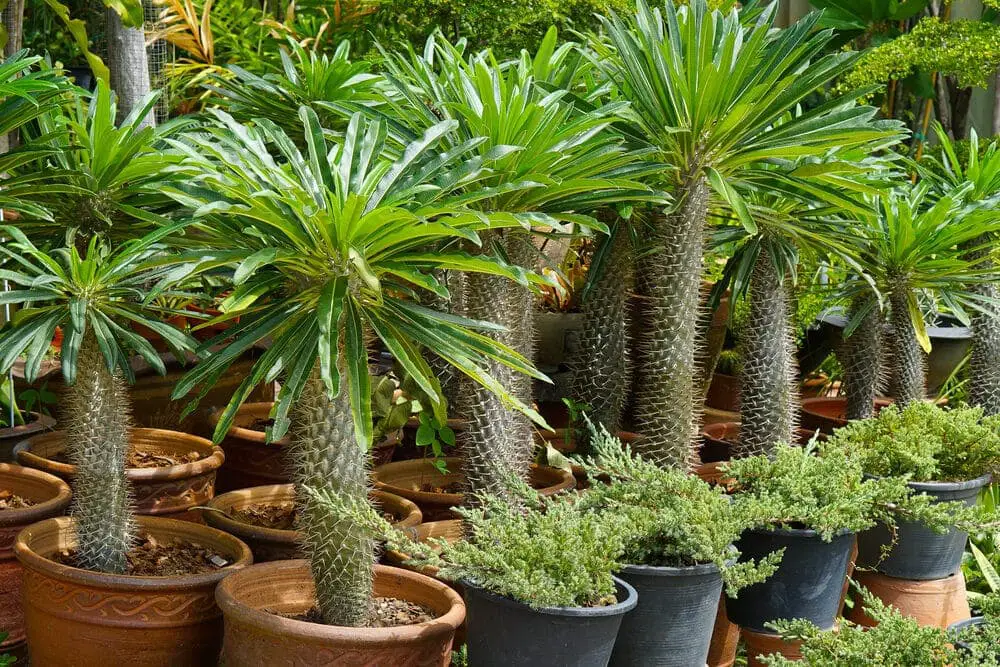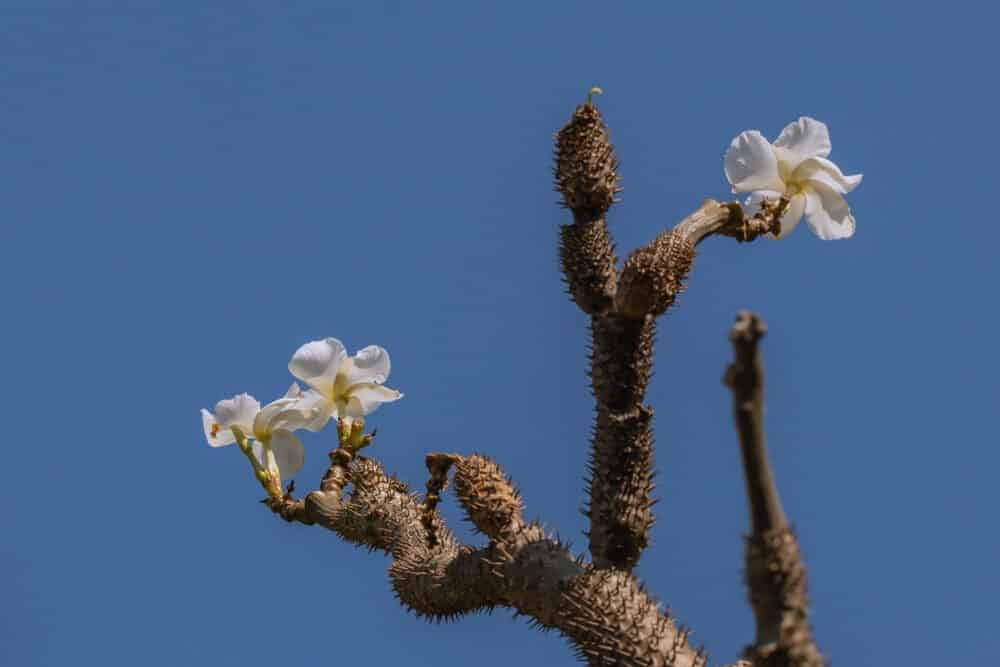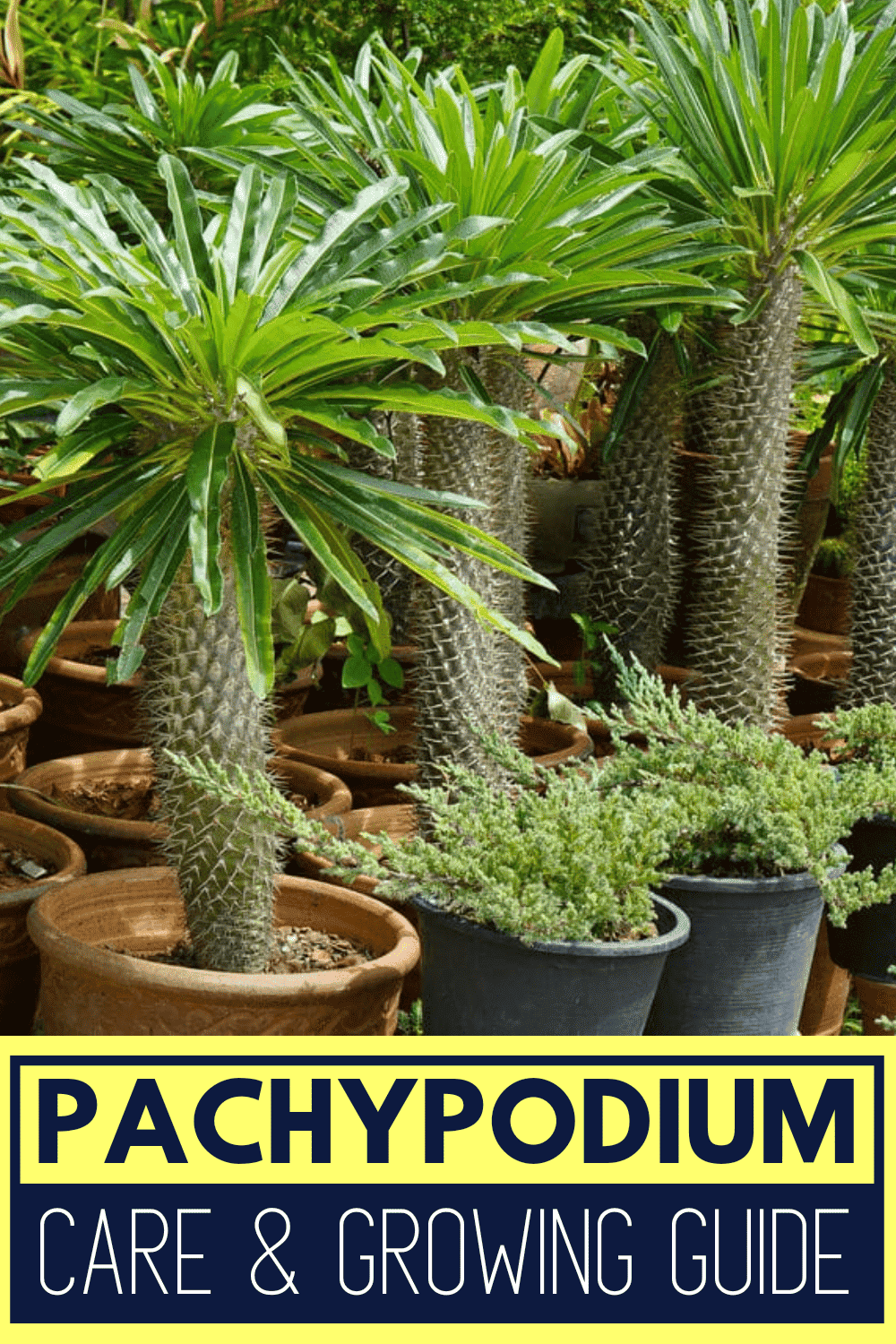The Madagascar palm comes all the way from, you guessed, it Madagascar! It is a beautiful flowering plant that is not easy to take care of if you are a beginning gardener.
It can grow quite tall if left alone, but trimming will keep it down. Despite what many people think, it is not a palm plant. It is actually a succulent plant!
Pachypodium Care & Growing Guide
1. Light Requirement
The plant should be kept in areas where there is a lot of lights, no matter if it is indoors or outdoors. But it is tough to keep it as a home plant as they need so much light. If they are indoors, keep them near a window that gets several hours of full sun a day.
If the palm is outdoors, then it will do fine in full, bright, indirect light, but full direct sunlight is best for this plant, as light affects its growing speed. Direct sunlight keeps it healthy and strong. If they are exposed to a lack of light, especially during the day, it may wilt.
2. Water
The Madagascar palm doesn’t like to be too wet. This plant is from an area where the land and climate is dry, so it requires small amounts of water. When it is time to be watered, soaked the plant completely to the point where it comes out of the drainage holes, then allow the topsoil dry before the next watering.
Never let the soil dry out completely. Adjust the watering between the seasons and the temperature in its environment. In the winter, you will have to water it less, and in the summer, you have to water it more.
3. Climate and temperature
This little plant loves to be in warm temperatures. Since the sun is a desert plant, it does not do well in cold temperatures. Do not let this plant be outside when it drops below 50 degrees Fahrenheit. The best hardiness zones for this plant is 9 to 11.

4. Soil
If this plant is going to be fertilized, you should use liquid fertilizer and dilute it a bit. It should not be fertilized during the winter. It should be fertilized in the spring and the summer.
The soil this type of palm should be in is cactus potting mix if it is an indoor plant. If it is in the ground, the land dry be well-draining and not have a lot of fertilizer already sowed in it.
5. Repotting
This plant needs to be repotted every three to four years when is roots begin to crowd. This will usually happen in the spring. Because of its height and weight, make sure to use a heavy bottom container to prevent it from falling over. When handling this plant, make sure not to stab yourself with one of its spines.
6. Speed of Growth
This plant has a quick growth rate, and if it is properly cared for, it can grow up to one foot per year. If it does not receive enough sun, its growth can begin to stunt.
7. Height and Spread
If the Palm is not trimmed back and controlled, it can grow up to 20 feet tall. The spread of its width depends on two things: the fullness of its leaves and the size of its trunk.
The spread at the top of the leaves might be more than 5 feet wide while its trunk can spread to one foot. Most gardeners keep this plant at 4 ft tall because they are easier to manage.
8. Trimming
Although you may think that this plant should be cut often because of its strong stem, that is not how this plant should be trimmed.
It doesn’t need much trimming at all in general, but when it is becoming too tall, then it must be pulled back. You must always trim foliage and leaves that are dead or dying.

Is the Madagascar Palm plant poisonous?
Yes, if humans or pets eat the leaves or stem of the Madagascar plant, they are very toxic and can cause severe distress to their gastrointestinal system. Even if you don’t eat the plant, you need to watch out for a spine that can cut and cause irritation to skin and fur.
Can Madagascar Palm Grow in Water?
No, the Madagascar palm does not grow well in water. It is a plant that likes heat and humidity and suffers greatly if its roots are waterlogged. However, it can be propagated in water for a small amount of time until the roots a long enough to absorb enough nutrients from the soil.
Does the Madagascar Palm have flowers, and how do I get them to bloom?
The flowers of the Madagascar palm are pink to red and yellow, and they tend to develop during the winter. If the Palm is older, it will flower during the Spring, and its flowers will have a pleasant fragrance.
More like this: Are Rubber Plants Toxic to Cats? Will My Cat Eat Them?
Common Madagascar Palm Pests and diseases
- Root rot develops on plants that are overwatered, and the water cannot escape. It favors conditions where the soil around the plant is damp, and the weather is hot. First, it will attack the roots, which a gardener cannot see. Then it’ll work its way up and start to brown the central stalk and lower stems of the home.
- To get rid of root rot, trim off all dead and disease parts. And then apply a strong fungicide to the plant. Continue this routine until there is no more rot.
- Scale bugs are small white or yellow or red bugs that can infest a plant and weaken its structure and kill it. They do this by sucking out the sap from the roots of the plant.
- To get rid of these pests, water down the palm no matter if indoors or outdoors. Water it as much as you can so you don’t see scales anymore. After the watering, apply neem oil or another intense soap. Repeat this until the plant no longer has bugs buzzing around it.
Also read:
Conclusion
- Another name for the Madagascar palm is the ghost man plant and the summer-blooming clubfoot.
- This plant is a member of the succulent family.
- If you fertilize this plant, do it during the summer, as well as the spring.
- This plant is from Southern Madagascar, but it is not a palm tree.
- This plant likes to be completely soaked, and then its soil should dry before its next watering
- This plant is prone to fungal rot around its roots.
- This palm is poisonous, and it shouldn’t be eaten by animals for humans.

Victoria is the owner and main author of hobby plants. She loves spending her free time in her garden planting and taking care of her plants. Victoria hopes you enjoy the content here!